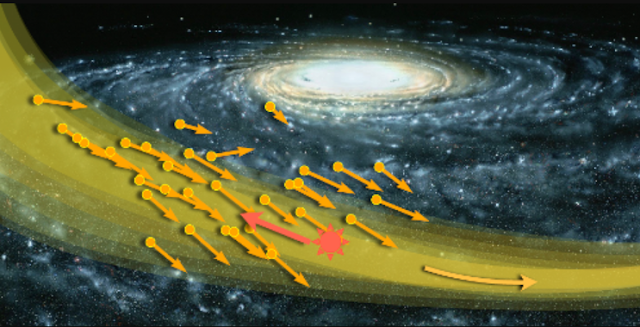The possibility of detecting dark matter on Earth could be unlocked by an upcoming “dark matter storm,” which is a celestial phenomenon that is drawing nearer.
Researchers have proposed the possibility of detecting a “storm” of dark matter on Earth as it moves away from the Sun. The study, authored by Ciaran O’Hare from the University of Zaragoza in Spain and published in Physical Review D, examined the S1 stream, a group of neighboring stars traveling in a unified direction. Scientists speculate that these stars may be remnants of a dwarf galaxy that was assimilated by the Milky Way billions of years ago.

The S1 stream, comprising roughly 30,000 stars, was discovered last year by the European Space Agency’s Gaia spacecraft, which aims to map a billion stars within the Milky Way. Gaia has uncovered approximately 30 similar streams, which are thought to have formed as a result of the merging of two other streams.
S1 is particularly intriguing as it is moving towards Earth at a velocity of approximately 500 kilometers per second (310 miles per second). Scientists believe that this could have an impact on the dark matter that surrounds us.
The current detectors that are being used to search for weakly interacting massive particles (WIMPs), a type of dark matter that is widely discussed, are unlikely to see any effect from S1. However, future WIMP detectors may be able to detect an impact.
Scientists suggest that all galaxies began from a massive halo of dark matter, which is unobservable and does not interact with regular matter. The researchers discovered that nearly 10 billion solar masses of dark matter from the original dwarf galaxy were in motion along the S1 stream.

“As the S1 stream ‘hits the Solar System slap in the face’, the authors write, its counter-rotating structure will dramatically increase the amount of dark matter appearing to come from the same patch of sky as the standard dark matter wind,” reports Cosmos Magazine.
The publication adds, “Indeed, it should generate a ring-like structure around this wind, which directed dark matter detectors… may easily detect in the future.”
ScienceAlert reports that axions, which are particles theorized to be 500 million times lighter than electrons and potentially indicative of dark matter, could be identified in the stream. “In the presence of a powerful magnetic field, these invisible ultralight particles could be converted into observable photons,” ScienceAlert stated.
To date, no direct observation of dark matter has been made. Nevertheless, this “storm” of dark matter could present a promising prospect for such a discovery.
Do not forget to share your opinion with us to provide you with the best posts !




0 Comments